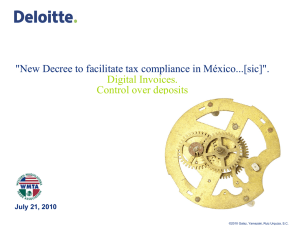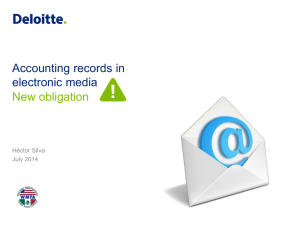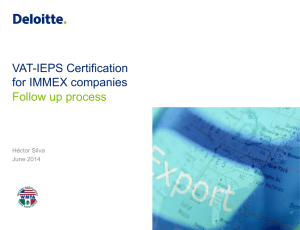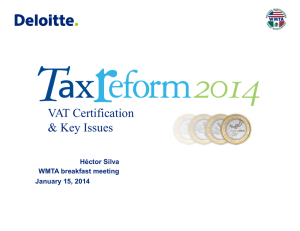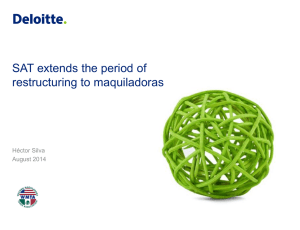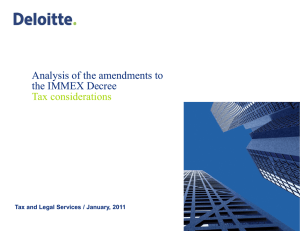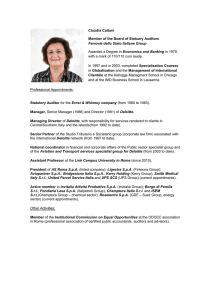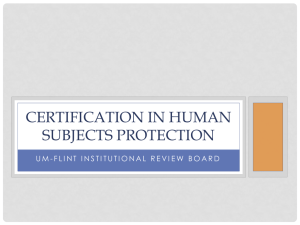SAT Extends the Period for Accounting Records
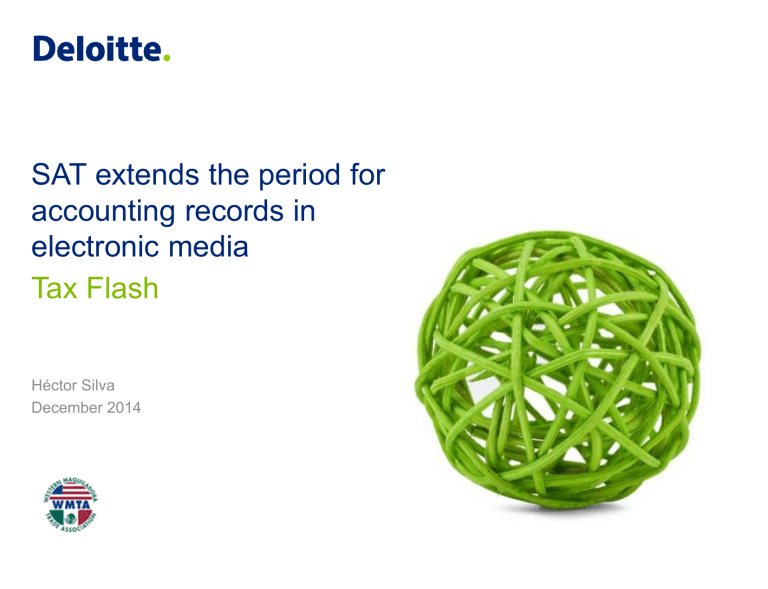
SAT extends the period for accounting records in electronic media
Tax Flash
Héctor Silva
December 2014
Accounting records in electronic media
New Rules
What stands out as the most important points are:
New deadlines to start fulfilling the obligation to send accounting records in electronic media
The new grouping code for the Chart of accounts
© 2014 Galaz, Yamazaki, Ruiz Urquiza, S.C.
2
Accounting
records in electronic media
Chart of accounts and trial balance
The chart of accounts used in the period and the trial balance must be delivered starting from January 2015 in the following cases:.
a) Institutions of the financial system.
b) Taxpayers whose taxable gross revenue in 2013 was equal or higher than Ps$4 million.
© 2014 Galaz, Yamazaki, Ruiz Urquiza, S.C.
3
Accounting
records in electronic media
Chart of accounts and trial balance
The chart of accounts used in the period and the trial balance must be delivered starting from January 2016 in the following cases:.
a) Taxpayers whose taxable revenue for 2013 was equal or lower to Ps$4 million.
b) Taxpayers engaged in farming, forestry, farming or fishing activities.
c) Non profit entities.
d) Taxpayers who enroll to the RFC during 2014 or 2015.
© 2014 Galaz, Yamazaki, Ruiz Urquiza, S.C.
4
Accounting
records in electronic media
Chart of accounts and trial balance
New taxpayers as from 2016 must upload their chart of accounts and the trial balance as from the first day of the next month after enrolling in the Taxpayer’s Registry (RFC).
© 2014 Galaz, Yamazaki, Ruiz Urquiza, S.C.
5
Accounting records in electronic media
Chart of accounts Grouping Code
The annex 24 has been modified and it is now more detailed in each account.
© 2014 Galaz, Yamazaki, Ruiz Urquiza, S.C.
6
Accounting records in electronic media
Deadlines for monthly Trial Balance a) Entities will send on a monthly basis, the trial balance within the first 3 days of the second month following, of the month that corresponds the information, i.e. the January information will be due by March 3.
b) Individuals, will send monthly the account information within the deadline of the first 5 days of the second month following of the month that corresponds the information.
© 2014 Galaz, Yamazaki, Ruiz Urquiza, S.C.
7
Accounting records in electronic media
Injunction - Amparo
Implementation of the requirement to submit electronic accounting records continues to be a challenge for Mexican taxpayers, both from an accounting and from an information technology capability perspective.
However, it is important to note that the electronic reporting requirement currently is being challenged through the court system – Mexico’s Supreme Court issued a decision on 26
November that temporarily suspends the requirement for taxpayers that have challenged the requirement on the grounds that it violates the Mexican constitution, and the decision must be applied by all courts in Mexico.
The suspension will be in effect until the Supreme Court decides whether the new obligation violates the constitution. Taxpayers that have not yet challenged the obligation can do so and obtain a suspension of the obligation once they havecomplied with the first reporting deadline (and continue filing not to jeopardize the Certification)
© 2014 Galaz, Yamazaki, Ruiz Urquiza, S.C.
8
9
Control of the tax credit for companies with VAT
(IVA) Certification
© 2014 Galaz, Yamazaki, Ruiz Urquiza, S.C.
Control of VAT (IVA) Certification
New obligations
The companies with IMMEX authorization, the automotive sector and those operating under customs regimes, such as fiscalized precinct and strategic fiscalized precincts which have been authorized with the Certification of the Value Added Tax (VAT) by the
Service Tax Administration (SAT); and those who choose to guarantee by letter of credit or bond the amount of VAT and IEPS caused by temporary imports under the above mentioned customs regimes, will have new obligations starting from January 1, 2015.
They must electronically transmit to SAT within the month following the completion of customs operations for each of the customs regimes in question, the discharge reports associated with each of the returned importation requests, regimen changes, virtual transfers, extractions, regularization of goods, information regarding the constancy of transfers of goods (CTM), or tax receipts that cover the sale of goods to companies in the terminal automotive industry or manufacturing of auto transportation vehicles, notices for donation and destruction of the operations subject to the credit or guarantees scheme.
© 2014 Galaz, Yamazaki, Ruiz Urquiza, S.C.
10
Control of VAT (IVA) and IEPS certification
New obligations
Annex 31 Credit Accounts and Guarantees Control System (SCCCyG) , that will come in to force on January 1, 2015 according to the transitory article provided for this publication.
The credit and bond control will be made through SCCCYG and the Companies will have to transmit the information through “ SAT’s web site ”.
In addition, the companies will have to transmit their temporary imports of raw materials and assets initial inventory trough SCCCYG within the first 30 calendar days of January 2015 . The closing date of the initial inventory must be on the at
December 31, 2014 .
The SCCCYG will automatically feed itself with the temporary imports information registered in the database of the Customs Automated System (SAAI).
© 2014 Galaz, Yamazaki, Ruiz Urquiza, S.C.
11
Control of VAT Certification
Maintaining VAT Certification.
The companies with VAT Certification must permanently meet the requirements for certification in the mode corresponding to them, since the non-compliance of the requirements could lead to cancellation.
In addition, observation for non-compliance with any of the obligations could result in the cancellation of Certification if it is not cured or disprove the situation.
© 2014 Galaz, Yamazaki, Ruiz Urquiza, S.C.
12
Control of VAT Certification
Maintaining VAT Certification
The requirements and obligations that the company must comply with are the following:
Having inventory control in accordance with the provisions of the SAT
Having the positive feedback current (30 calendar days) of compliance with tax obligations of:
The company
Legal representative
Outsourcing providers
Partners
Legal representative
Administration counsel
Suppliers of direct inputs and packaging in Mexico 40% or 70% (virtual and direct purchases)
Shareholders
Additionally, the company must report monthly to the SAT, changes in any of the above mentioned, as well as to clients and suppliers abroad.
© 2014 Galaz, Yamazaki, Ruiz Urquiza, S.C.
13
Control of VAT Certification
Maintaining VAT Certification
Evidence that the outsourcing service provider meets the obligations of:
Withhold and pay the income tax for workers,
Keep current contract and
Be current in the payment of worker-employer contributions
Allow at all times access to AGACE staff to the initial inspection visit and compliance monitoring.
Have registered with the SAT all addresses or establishments in conducting activities related to the program of maquila or export.
Evidence that over the past twelve months, the value of the merchandise transformed and returned, returned in the same condition, with regime changes during that period represents at least 60% or 80% of the value of temporary imports of inputs.
© 2014 Galaz, Yamazaki, Ruiz Urquiza, S.C.
14
Control of VAT Certification
Maintaining VAT Certification
Evidence that the company has a maquila contract, purchase, purchase order or service or firm orders in effect, proving the continuity of export project.
That partners and shareholders, legal representative, sole director or member of the board of the company prove that they declared in annual statements of the two previous fiscal years taxable income to the tax authorities for income tax purposes.
That there has been no credit identified to them by the SAT in the last 24 months preceding the date of filing or credits are paying for it in installments.
That there hasn’t been issued a invalidity resolution of VAT refunds requested in the past 12 months, which amount represents more than 20% of all authorized returns in the same period, provided that the amount denied resulting from the application of this percentage not exceeding five million pesos as a whole.
© 2014 Galaz, Yamazaki, Ruiz Urquiza, S.C.
15
Control of VAT Certification
Maintaining VAT Certification
Give notice to the ACALCE, within no more than five days, of any change of corporate name, legal address, or the address or addresses which makes the production process.
Perform all foreign trade operations with carriers that have registration CAAT
(Harmonized Carrier Alpha Code)
Perform electronically the registration of the companies with whom performs the importation requests of virtual transfer and RFC data of the companies that perform maquila sub-processes.
© 2014 Galaz, Yamazaki, Ruiz Urquiza, S.C.
16
Control of VAT Certification
Maintaining VAT Certification
Transmit electronically in accordance with Annex 31, through the SAT’s web page within the month following the close associate of the operations performed by each of the types of customs downloading destinations, reports of releases
To transmit electronically, inventory transactions that are under the temporary scheme
(IMMEX), the day immediately prior to the entry into force of certification, no later than
30 calendar days after that date.
When derived from the power of inspection its not proven that the temporarily imported goods were returned abroad, transferred or went to another customs procedure, within the time allowed.
When the legal stay of foreign trade goods for more than 100,000 pesos has not been proved and not the tax credit identified is covered by the SAT
Keep up to date with the compliance of customs and tax duties.
© 2014 Galaz, Yamazaki, Ruiz Urquiza, S.C.
17
Héctor Silva Rodríguez
Tax Partner
011 52 (664) 622 7840 hsilva@deloittemx.com
Deloitte se refiere a Deloitte Touche Tohmatsu Limited, sociedad privada de responsabilidad limitada en el Reino Unido, y a su red de firmas miembro, cada una de ellas como una entidad legal única e independiente. Conozca en www.deloitte.com/mx/conozcanos la descripción detallada de la estructura legal de Deloitte Touche Tohmatsu Limited y sus firmas miembro.
Deloitte presta servicios profesionales de auditoría, impuestos, consultoría y asesoría financiera, a clientes públicos y privados de diversas industrias.
Con una red global de firmas miembro en más de 150 países, Deloitte brinda capacidades de clase mundial y servicio de alta calidad a sus clientes, aportando la experiencia necesaria para hacer frente a los retos más complejos de los negocios. Cuenta con alrededor de 200,000 profesionales, todos comprometidos a ser el modelo de excelencia.
Tal y como se usa en este documento, “Deloitte” significa Galaz, Yamazaki, Ruiz Urquiza, S.C., la cual tiene el derecho legal exclusivo de involucrarse en, y limita sus negocios a, la prestación de servicios de auditoría, consultoría fiscal, asesoría financiera y otros servicios profesionales en México, bajo el nombre de “Deloitte”.
Esta publicación sólo contiene información general y ni Deloitte Touche Tohmatsu Limited, ni sus firmas miembro, ni ninguna de sus respectivas afiliadas
(en conjunto la “Red Deloitte”), presta asesoría o servicios por medio de esta publicación. Antes de tomar cualquier decisión o medida que pueda afectar sus finanzas o negocio, debe consultar a un asesor profesional calificado. Ninguna entidad de la Red Deloitte, será responsable de pérdidas que pudiera sufrir cualquier persona o entidad que consulte esta publicación.
